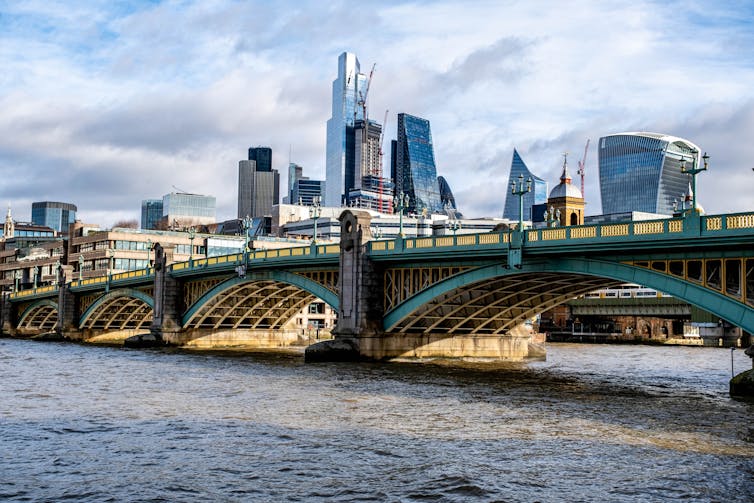
Britain has a bigger inflation problem than either the US or the eurozone, according to Bank of England policymaker Catherine Mann.
The latest official UK inflation figures show UK price rises have slowed from double digits to 8.7% for the 12 months to April 2023. But this is still above the 8.2% rate forecast by the Bank of England earlier this year.
The UK rate is also nearly double the equivalent US rate and significantly higher than the eurozone’s 7% rate of inflation for April, which slowed to 6.1% for May.
All three regions experienced the economic shock of the COVID-19 pandemic. EU countries and the UK struggled with dramatically rising energy prices due to Russia’s war in Ukraine. But two UK-specific issues are exacerbating the country’s inflation woes: the adverse economic shock of Brexit, and the UK’s reliance on its financial services sector.
As a result, interest rate rises by the Bank of England will not be enough to reduce inflation. The UK government should also play a role by rebalancing the post-Brexit economy away from financial services towards other traditional industries such as manufacturing.
Interest rates are a blunt instrument for fighting inflation, but they continue to be central banks’ main tool. They affect the economy in several ways. The most obvious is in reducing demand for goods and services by increasing the cost of different forms of debt (such as mortgages).
But interest rates also affect whether businesses can meet their debt repayments and reduce the value of the collateral they provide to banks to secure their loans. This weighs on banks’ balance sheets and so interest rate increases adversely affect the financial sector because it there is a greater risk that these borrowers won’t be able to repay their loans. This is why an oversized financial sector creates headaches for the Bank of England when it tries to tackle inflation.
The UK’s industrial past
In the 1950s, the UK had a balanced economy more evenly distributed between manufacturing and the service sector. Manufacturing (including gas, electricity and water utilities) contributed over 40% of total UK economic output in the 1950s while the service sector accounted for 50%. The UK was responsible for a quarter of world trade in manufacturing.
The government of the day prioritised production for export, making the UK a leading shipbuilder, and a European hub for producing cars, coal, steel and textiles to sell to other countries. Science-based industries, such as electronics, computers and engineering were also taking off in the UK, and the country benefited from this third technology revolution.
But advances in science-based industries did not happen soon enough to balance out a collapse in employment in manufacturing in the UK from the 1960s onwards. By 2011 around 80% of British workers were in service industries and only 10% in manufacturing. Various factors explain this decline in manufacturing jobs, including routine jobs being replaced by robots and computerised systems, rising imports from China and other emerging countries, and government policy.
In the 1970s, the government championed economic policies geared towards a housing boom and the financial hub of the City of London. The British public were told their future lay in working with their brains and not their hands. De-industrialisation policies were instigated by UK prime minister Margaret Thatcher and continued under Tony Blair and David Cameron.
These policies were presented as economic modernisation that would improve workers wages and society as a whole. Even the Labour government, traditionally associated with the working class, was convinced the future lay in the knowledge economy and embarked on making Britain a global service provider.

The rise of the City of London, and the finance, insurance, and real estate industries, under both Conservative and Labour governments has changed the economic trajectory of Britain. For example, the City has sucked the best-educated people out of other regions and careers and into high-salaried London-based jobs. People who might have become scientists or engineers became bankers or hedge fund managers instead.
So, even though the City generates £85 billion per year and employs over 580,000 people, it is not a goose that lays Britain’s golden eggs but rather a cuckoo in the nest. It has crowded out other sectors that traditionally allowed the whole country to prosper.
And the UK financial sector is now causing another problem: its dominance has made it more difficult for the Bank of England to control inflation because of the concerns about how higher interest rates will weigh on bank balance sheets.
Tackling ‘stubborn’ inflation
This is why monetary policy alone will not be able to tame UK inflation. The bank has spoken about the difficulties it has faced in anticipating the recent rise and persistence of inflation. But advancements in statistical techniques and computation power have improved the ability to forecast inflation. On the other hand, unexpected government policies and the structure of the UK economy may have presented more of a challenge.
The bank’s models had little chance to account for the political turmoil and strategy changes resulting from Brexit. For example, trade has become significantly more difficult between the UK and EU following Brexit, reducing supply and pushing up prices. There are also more people from the EU leaving than arriving in the UK, putting pressure on wages in particular sectors and adding to the inflation problem.
Brexit, coupled with the oversized UK financial sector, makes the Bank of England’s job of controlling inflation so much harder. The government needs to rebalance the UK economy, with science-based industries playing an important role. This would ensure the Bank of England could adjust interest rates to tackle inflation, without having to worry about how it affects the over-sized financial services sector.
Edward Thomas Jones, Lecturer in Economics / Director of the Institute of European Finance, Bangor University and Yener Altunbas, Professor of Banking, Bangor University
This article is republished from The Conversation under a Creative Commons license.
